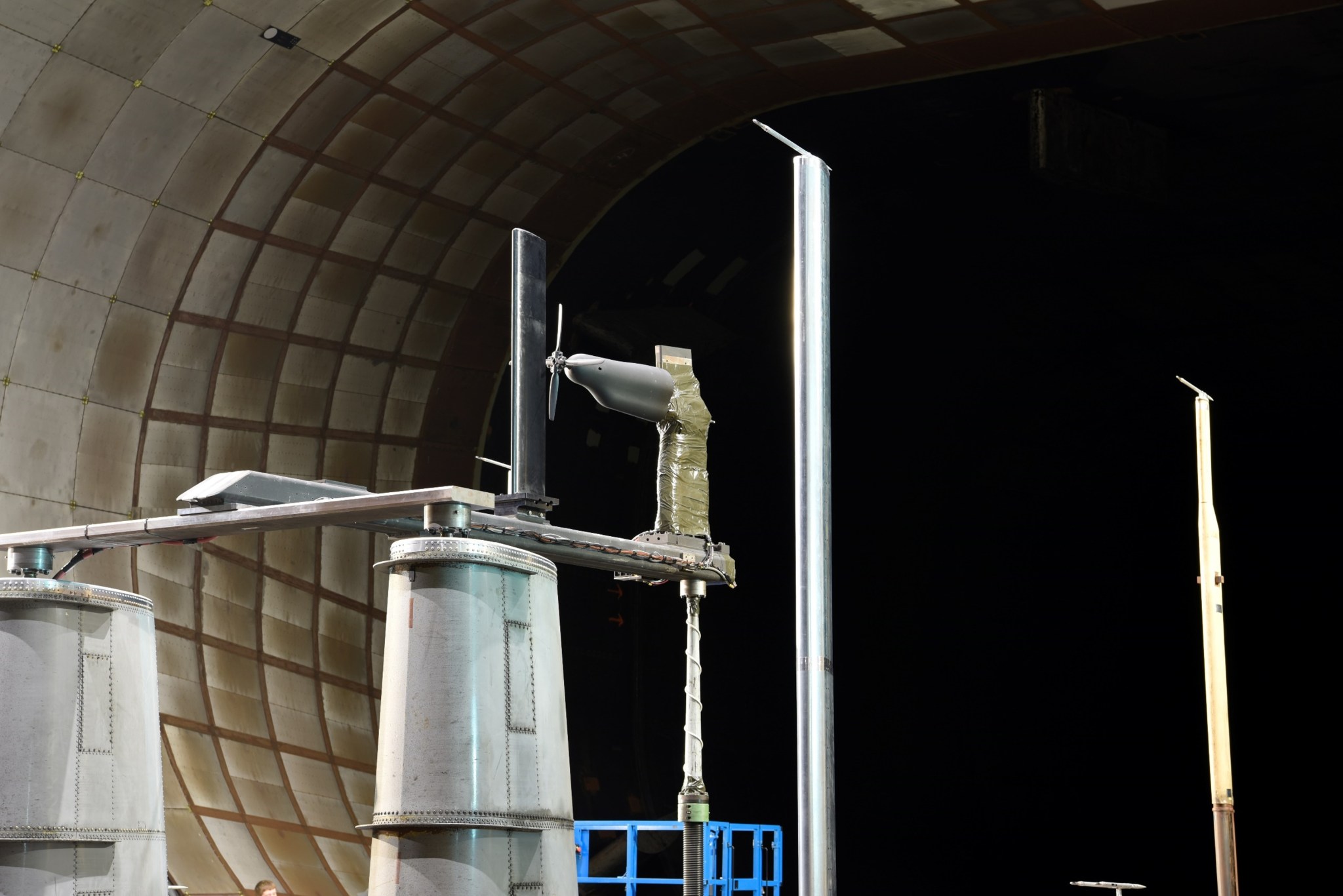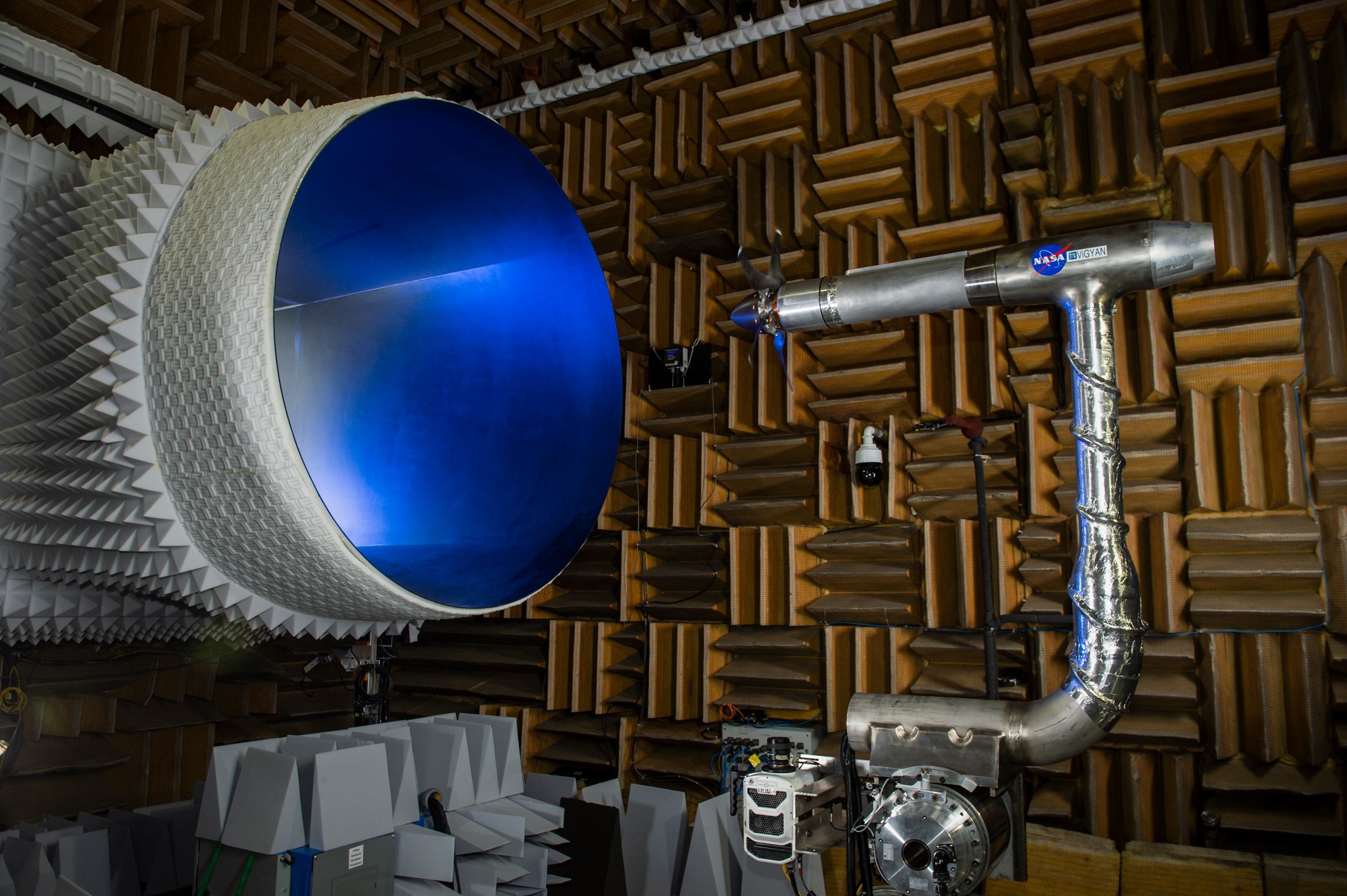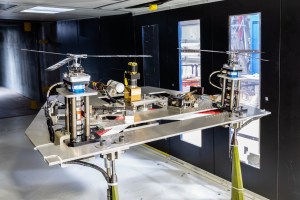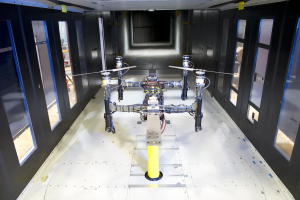New Multirotor Testbed Operational
Multirotor aircraft have seen a drastic increase in popularity during the past five years, both for small-scale Unmanned Aircraft System operations, and as the design of choice for vehicles targeting the Advanced Air Mobility (AAM) market with two to four passengers.
The lack of test and validation data for multirotor aircraft presents a serious challenge for researchers and vehicle designers who need to predict the effects of the highly complex interacting flows of multirotor systems.
One of the goals of the Revolutionary Vertical Lift Technology (RVLT) project is to create a test capability that allows for wind tunnel testing of reconfigurable multirotor systems; allows measurement of individual rotor loads in both edgewise and axial flows, as well as at the in-between conversion angles; and potentially allow acoustic testing of multirotor systems.
RVLT designed and fabricated a new Multirotor Test Bed (MTB) capable of simultaneous testing of at least six rotors of up to 24 inches in diameter. Maximum individual rotor thrust is approximately 30 pounds. Each rotor has its own six-axis load measurement system measuring up to 75 pounds of thrust. The primary test environment for the MTB is the U.S. Army 7- by 10-foot wind tunnel at NASA’s Ames Research Center in California, with testing at low speeds. Independent variables under control are wind speed, individual rotor tilt, rotor spacing (horizontal and vertical), full rig tilt, and rotor speed.
RVLT has successfully tested the MTB in the 7- by 10-ft wind tunnel at wind speeds from zero to 40 feet per second, with total rotor power up to five kilowatts in various rotor configurations, demonstrated operation of the individual six-axis rotor loads measurement systems, and generated a large data set for multiple rotor configurations. This provides a unique test capability that has been developed and demonstrated to allow high quality measurements of reconfigurable multirotor system performance. This capability will enable enhanced modeling of advanced Vertical Take Off and Landing configurations for AAM applications for future testing and accelerate the development of this class of aircraft.
Aerodynamic and Acoustic Rotorprop Test
AAM vehicles often incorporate a pusher propeller for the cruise portion of the mission. However, there is limited acoustic data that explores the acoustic effects of upstream bodies on pusher propeller noise, efficiency, and vibrations.
The RVLT project partnered with the U.S. Army Combat Capabilities Development Command, Aviation and Missile Center to acquire high quality acoustic data for a pusher propeller as part of the Aerodynamic and Acoustic Rotorprop Test (AART) program in the National Full-Scale Aerodynamics Complex (NFAC) 40- by 80-foot wind tunnel. This test campaign was designed to validate modeling and simulation tools and increase the available acoustic data literature for various flight conditions and wing configurations such as no wing, half wing, and full wing.
A test in that wind tunnel acquired acoustic data using eight microphones placed around the AART test stand to provide a uniform azimuthal distribution to validate modeling and simulation tools, as well as acquire data at locations that most affect the community during flyover conditions. Data were acquired over a range of flight conditions, including sweeps of yaw, advance ratio, tunnel Mach number, tip Mach number, and thrust coefficient for multiple wing configurations.
The data are repeatable and with adequate signal-to-noise to be able to distinguish the propeller noise. This effort adds to the limited available acoustic data sets for pusher propeller noise and installation effects, and the data will provide a good source for comparison data for future propeller testing.
Demonstration of New Propeller Test Stand
AAM vehicles often incorporate a pusher propeller for the cruise portion of the mission. However, there is limited acoustic data that explores the acoustic effects of different propellers and their aerodynamic capabilities. The RVLT project designed and fabricated a new Propeller Test Stand (PTS) to provide the capability to assess aerodynamic and acoustic capabilities of propellers operating at different rotation rates and flow speeds within the Low Speed Aeroacoustic Wind Tunnel.
The objectives of the research were to determine the accuracy of aerodynamic performance measurements made by the PTS; test PTS capabilities when subjected to angles of incidence such as roll, pitch, and yaw; compare acoustic measurements against low-fidelity acoustic predictions; and identify potential sources of noise contamination by the PTS in the wind tunnel.
The PTS was tested at a range of advance ratios for two propellers including the full range of load measurement capability and acoustic surveys of the two-foot-diameter propellers were performed. The test plan included both performance and acoustic data that were collected for a wide range of flight conditions and allowed for the identification of repeatability issues with thrust measurements under some conditions. The acoustic data were compared to predictions and appropriate trends were confirmed.
This effort has demonstrated the operational readiness and functionality of a large PTS that can be used in multiple facilities for AAM configuration acoustic and performance testing of propellers.
Techniques for Novel Vertical Lift Testing Developed
The need for high quality experimental data, to be taken within the context of the challenging environment surrounding rotating test articles, drives a need for enhancements to be developed to existing experimental techniques. The enhancements will enable the documentation of important quantities across the entire surface of a rotating blade.
For example, pressure sensitive paint (PSP) will quantify the surface pressure distribution, infrared thermography (IR) will establish transition locations along the length of the blade, and high-resolution measurements verify the as-built three-dimensional geometry of the blade itself.
The RVLT project has developed novel enhancements to existing experimental techniques which address the unique set of challenges that are part of vertical lift research and are suitable for use measuring parameters on rotating blades. The approach has been to take existing experimental techniques and develop, customize, and refine them to enable the measurement of quantities of interest in vertical lift experimental campaigns.
Recently the project has continued development of new PSP formulations to enable unsteady measurements and to enable measurements in low-oxygen, low-pressure environments. The project has invested in multiple generations of a blade de-rotation imaging system to enable IR imaging of a single blade at any azimuthal location with minimal image blur. Advancements in digital scanning techniques have resulted in documenting the 3D digital geometry for a UH-60 helicopter blade, a 11-foot transonic wind tunnel fan blade, an XV-15 Tiltrotor VTOL aircraft blade, and the entire XV-15 aircraft in situ at the National Air and Space Museum’s Steven F. Udvar-Hazy Center in Virginia.
The advances in experimental capability have improved other research. The development effort for the blade de-rotation imaging system for transition detection enabled forward flight transition work in the 14- by 22-foot Subsonic Wind Tunnel at NASA’s Langley Research Center in Virginia. The imaging system will be used in the future on a benchmark hover test in the NFAC. The benchmark hover test also will utilize the advancements in the IR technique. The PSP work also spawned a carbon-based heating layer formulation that was leveraged for the work in transition detection.
Evaluation of eVTOL Disturbance Rejection and Control Response Criteria
The propulsion and flight control systems of electric Vertical Take Off and Landing (eVTOL) configurations using rotor speed to modulate thrust are tightly integrated, which means the engines also serve as the flight control actuators. The flight control system can impose highly dynamic and varied torque and power demands on the engines, which creates a dependence on the disturbance rejection and agility required of the design. The interaction of the flight control and propulsion system can lead to handling qualities and pilot workload that are much different than conventional helicopter systems.
The RVLT project is conducting research in handling qualities and flight control system design criteria and recently conducted a pilot-in-the-loop simulation in the Vertical Motion Simulator at Ames that evaluated two versions of the RVLT reference quadrotor flight dynamics models.
One model used blade pitch for control and the other model used rotor speed for thrust modulation. Each was configured with control laws designed to provide varying levels of disturbance rejection and control response. The purpose of the testing was to assess applicability of existing handling qualities to an AAM mission flight control system design criteria for heave disturbance rejection and control response and to record representative aircraft kinematics for a follow-on study to assess motion sickness measurement experimental techniques. The models were evaluated against baseline maneuvers and higher-precision AAM-tailored tasks by six test pilots.
The initial test campaign was successfully completed with more than 500 data runs and it collected objective and subjective handling qualities data for various parameters such as disturbance rejection and control response bandwidth settings; two different levels of augmentation; for hover, vertical maneuver, and lateral reposition maneuvers; and for both simulated turbulence and calm wind conditions. The simulation demonstrated the connection between aircraft handling qualities and pilot workload during normal approach and landing operations for AAM vehicle configurations that will be used to establish a baseline set of flight control system design criteria and guide future analytical and experimental flight control system designs for AAM vehicles.
































